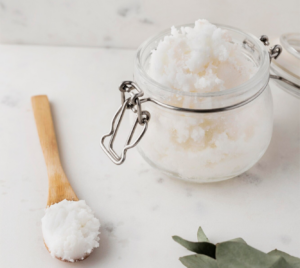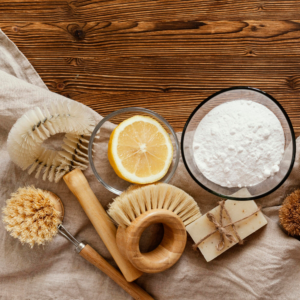In the world of DIY health remedies, it doesn’t take much for a trend to go viral—especially when TikTok gets involved. Lately, videos discussing the use of baking soda baths for yeast infections have been blowing up on social media.

The idea behind it is simple and appealing: a natural, inexpensive solution that promises relief from one of the most uncomfortable conditions women face.
But does it actually work? Can a basic pantry item like baking soda really ease the itching, burning, and discomfort of a yeast infection?
A baking soda bath may help relieve itching and irritation from yeast infections by balancing pH and soothing inflammation naturally.
In this article, we’ll take a deep dive into the science (and myths) behind baking soda baths for yeast infections, how to use them safely, potential risks, and whether or not they are a viable alternative or complement to traditional antifungal treatments.
Understanding Yeast Infections
Before we get into the remedy itself, it’s important to understand what a yeast infection is. A vaginal yeast infection, also known as candidiasis, is caused by an overgrowth of a fungus called Candida albicans.
While Candida naturally lives in the vagina in small amounts, problems arise when the balance of yeast and bacteria is thrown off—often due to antibiotics, hormonal changes, uncontrolled diabetes, a weakened immune system, or even stress.
The most common symptoms include itching, burning, redness, swelling, thick white discharge, and discomfort during sex or urination. While these infections are usually not serious, they can be incredibly irritating and disruptive to everyday life.
The TikTok Trend: Why Baking Soda?
So why is baking soda suddenly trending as a cure-all for yeast infections? It comes down to its alkaline nature. Baking soda (sodium bicarbonate) is a natural compound known for neutralizing acids.
Since yeast thrives in a warm, moist, and slightly acidic environment, the theory is that soaking in a baking soda bath can help neutralize vaginal pH, creating an environment less favorable for yeast to grow.
Additionally, baking soda is known to have anti-fungal and anti-inflammatory properties, which may help relieve some of the symptoms, such as itching and irritation.
Some proponents even claim it can offer near-instant relief, making it an attractive home remedy for those seeking quick and natural solutions.
What the Science Says
Despite its rising popularity online, scientific research on baking soda baths as a primary treatment for yeast infections is limited. However, some studies and anecdotal evidence offer a bit of insight.
For instance, one study published in the Journal of Mycopathologia found that sodium bicarbonate inhibited the growth of Candida albicans in a lab setting. This suggests that baking soda does possess antifungal activity, at least in controlled environments.
Another study in Oral Microbiology and Immunology explored baking soda’s role in treating oral thrush, a yeast infection of the mouth.
It concluded that sodium bicarbonate could reduce fungal colonization in the oral cavity. While the vagina and mouth are different environments, the antifungal effect could theoretically translate.
Still, it’s crucial to note that lab results don’t always equal real-life effectiveness—especially when dealing with complex body systems like the vaginal microbiome.
There’s a lack of large-scale clinical trials confirming baking soda baths as a standalone treatment for yeast infections. Most medical professionals still recommend antifungal medications, such as fluconazole or over-the-counter options like miconazole and clotrimazole, as the first line of treatment.
How to Take a Baking Soda Bath for Yeast Infection
For those curious about trying a baking soda bath at home, it’s essential to follow a safe and gentle process to avoid further irritation.
Here’s how to do it:
- Fill your bathtub with warm (not hot) water. Lukewarm water is soothing and less likely to cause skin irritation.
- Add 1/4 to 1/2 cup of baking soda to the bath.
- Stir the water to dissolve the powder thoroughly.
- Soak in the bath for 10 to 20 minutes. Try to relax and allow the solution to come in contact with the affected area.
- After your soak, pat yourself dry gently with a clean towel. Avoid rubbing the skin, which could worsen irritation.
You can do this once a day for a few days, but if your symptoms don’t improve—or if they get worse—stop immediately and consult a healthcare provider.
Can Baking Soda Baths Cure Yeast Infections?
While baking soda baths may help relieve symptoms such as itching and burning, they are not a cure for yeast infections.
At best, they can provide temporary relief and act as a supportive measure while waiting for antifungal treatments to work. It’s more accurate to think of baking soda as a soothing soak rather than a medical solution.
If you’re dealing with recurrent yeast infections, it’s especially important to get to the root of the problem. Frequent infections could point to an underlying condition, such as diabetes or immune dysfunction. Relying solely on home remedies could delay proper diagnosis and treatment.

What About Baking Soda Douches?
Some online sources—and TikTok creators—go one step further and suggest using baking soda as a douche. This involves mixing baking soda with water and inserting it into the vagina using a douche bottle or similar applicator.
This is not recommended. Douching of any kind is widely discouraged by medical professionals because it can disturb the natural balance of bacteria and yeast in the vagina, potentially making infections worse.
It can also increase the risk of pelvic inflammatory disease (PID) and other complications. If you want to use baking soda, stick to external baths only. Avoid inserting it directly into the vaginal canal.
Risks and Precautions
Although baking soda is generally safe for external use, there are still a few things to keep in mind:
- Skin Sensitivity: Some people may experience skin irritation or allergic reactions to baking soda. If you notice increased redness, itching, or a rash, discontinue use.
- Altering Vaginal pH Too Much: While an alkaline environment can hinder yeast growth, overdoing it may disrupt the vaginal flora, leading to bacterial vaginosis or other imbalances.
- Not a Replacement for Medical Advice: Home remedies should never replace professional medical care. If you’re unsure whether your symptoms are due to a yeast infection—or if this is your first time experiencing symptoms—see a doctor for a proper diagnosis.
Who Should Avoid Baking Soda Baths?
Not everyone should jump into a baking soda bath without hesitation. If you have open wounds, sensitive skin, or chronic skin conditions such as eczema or psoriasis, baking soda may cause stinging or discomfort.
Pregnant women should also consult their healthcare provider before trying any home remedy, even seemingly harmless ones like baking soda baths.
People with frequent vaginal infections should seek medical help instead of relying solely on at-home remedies. Recurring symptoms might be a sign of an underlying issue, such as antibiotic resistance, hormone imbalance, or immune system dysfunction.
Alternative Natural Remedies
If you’re looking for other natural ways to ease yeast infection symptoms, there are a few alternatives that may help:
- Probiotics: Yogurt containing live cultures or probiotic supplements may help restore the balance of healthy bacteria.
- Coconut Oil: Has mild antifungal properties and can be used externally to soothe irritated skin.
- Tea Tree Oil: Some studies show tea tree oil has antifungal effects, but it must be diluted properly and should never be applied internally.
- Apple Cider Vinegar Baths: Another popular bath soak, though it’s more acidic and can cause irritation in some people.
Always do a patch test and consult your doctor before trying new home remedies.
Conclusion
The viral buzz around baking soda baths for yeast infections is rooted in some logic—baking soda does have antifungal and soothing properties.
For many, a warm soak with a bit of baking soda might offer temporary relief from itching and irritation, especially when used alongside prescribed treatments.
However, it’s important to understand that this method is not a cure and is best used as a complementary option rather than a standalone solution.
If you’re suffering from a yeast infection, your first step should be a proper diagnosis. Self-diagnosing based on internet trends can lead to mismanagement of your condition and worsen symptoms over time.
If you’ve tried baking soda baths and haven’t seen improvement—or if the infection keeps coming back—don’t wait. Talk to your healthcare provider for guidance and long-term solutions.
Baking soda might be a helpful ally in your at-home care routine, but like many TikTok trends, it should be approached with a dose of skepticism and a lot of common sense.
